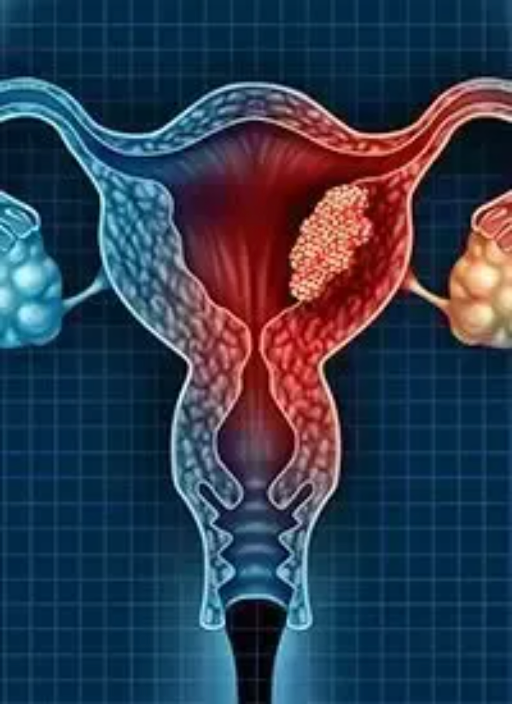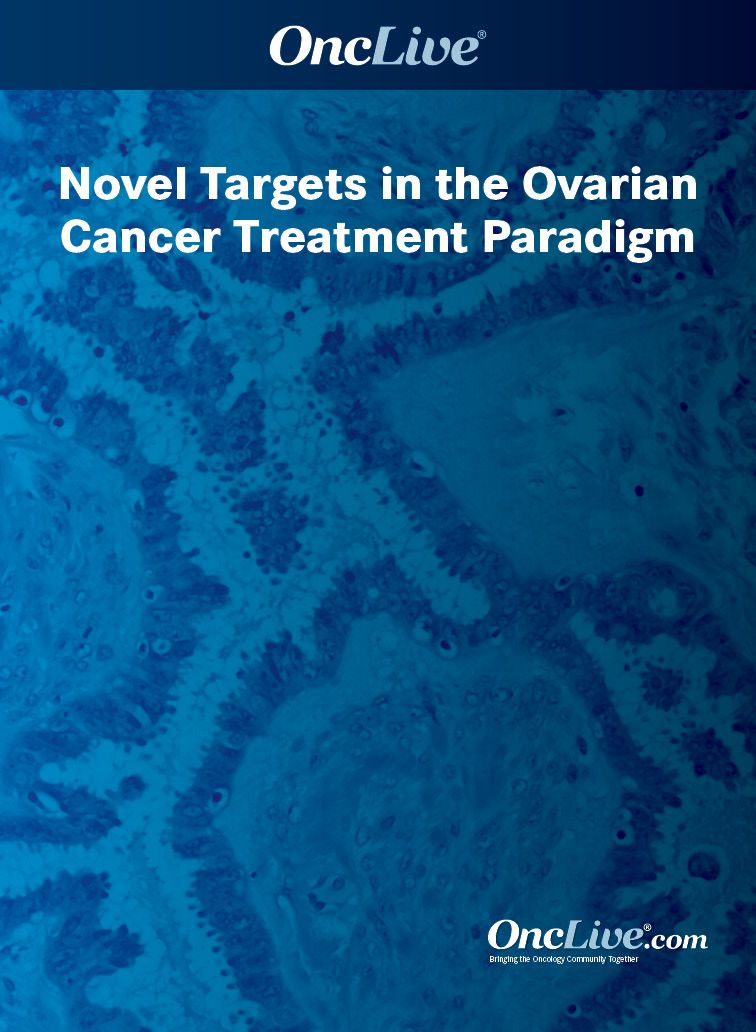Publication
Article
Supplements and Featured Publications
UpRi Looks to Add Superior Treatment Option in Platinum-Resistant Ovarian Cancer
Author(s):
Investigators are hoping to dramatically improve the platinum-resistant ovarian cancer treatment paradigm with the development of the first-in-class antibody-drug conjugate upifitamab rilsodotin.
Ovarian Cancer

Patients with platinum-resistant ovarian cancer have long represented an area of unmet medical need; standard-of-care treatments such as pegylated liposomal doxorubicin and topotecan have displayed response rates only up to approximately 12% and median progression-free survival (PFS) times of approximately 4 months. Investigators are hoping to dramatically improve the platinum-resistant ovarian cancer treatment paradigm with the development of the first-in-class antibody-drug conjugate (ADC) upifitamab rilsodotin (UpRi; XMT-1536).1
“Recurrent ovarian cancer remains a high unmet need because [essentially] every patient who gets it dies,” Bradley J. Monk, MD, said in an interview with OncologyLive®. “When patients respond to platinum [chemotherapy], generally the platinum doublet liposomal doxorubicin, but sometimes paclitaxel or gemcitabine with or without bevacizumab [Avastin] and sometimes with a PARP inhibitor in the maintenance [setting]. [When the regimens are effective] that’s great, but it’s not enough because those patients ultimately recur and die of their disease.”
Monk is aprofessor in the professor on the Clinical Scholar Track at the University of Arizona College of Medicine – Phoenix, medical director of US Oncology Gynecologic Oncology Research, and codirector of GOG Partners.
In August 2020, UpRi received fast track designation from the FDA for the treatment of patients with platinum-resistant high-grade serous ovarian cancer who have received up to 3 prior lines of systemic therapy or those previously treated with 4 prior lines of systemic therapy regardless of platinum status.2 UpRi targets the sodium-dependent phosphate transport protein NaPi2b, which is widely expressed in ovarian cancer but has limited expression in normal tissues, making it a potential target of therapeutic interest.2,3
UpRi is engineered with a linker designed to specifically to interact with cancer cells and contains a DolaLock payload that traps the drug inside cells after diffusion throughout the tumor. The DolaLock payload is a proprietary auristatin cytotoxic agent that uses the bystander effect to potently target rapidly dividing cells.4
“[NaPi2b] is a lineage marker and is not an oncogene,” Debra L. Richardson, MD,associate professor in the Section of Gynecologic Oncology of the Oklahoma TSET Phase I Program at Stephenson Cancer Center of The University of Oklahoma (OU) College of Medicine of OU Health in Oklahoma City, said in an interview with OncologyLive®. “Some other ADCs under development in ovarian cancer target other antigens, [for example] mirvetuximab soravtansine that targets folate receptor [α] and other ADCs targeting mesothelin. UpRi is a first-in-class dolaflexin ADC, which has a controlled bystander effect. [The drug-to-antibody ratio] of UpRi is high, at approximately 10.”
Ongoing Clinical Trials Examining UpRi
Investigators are evaluating UpRi in the phase 1/2 UpLift registration trial (NCT03319628), with plans to enroll approximately 100 patients with platinum-resistant ovarian cancer with high NaPi2b expression and approximately 180 patients with platinum-resistant ovarian cancer in the pivotal experimental cohort. The trial also includes a cohort for patients with non–small cell lung cancer, for a total of approximately 444 patients.5,6
Patients received intravenous UpRi once every 4 weeks until disease progression, unacceptable toxicity, or study discontinuation. In the dose escalation portion, the starting dose of UpRi was 36 mg/m2 increasing to up to 43 mg/m2. The recommended phase 2 (RP2D) dose was determined to be 36 mg/m2 and the dose-escalation portion of the trial is now closed to enrollment.
To be eligible for the trial, patients must have measurable disease, adequate organ function, and an ECOG performance status of 1 or less. Patients with low-grade, clear cell, endometrioid, mucinous, carcinosarcoma, germ-cell, mixed histology, or stromal tumors will not be included in the study.
“[The UPLIFT trial] is targeting platinum-resistant patients with 1 to 4 prior lines of therapy, so somewhat heavily pretreated patients,” Richardson said. “If patients only have had 1 to 2 prior regimens, prior bevacizumab is required. Patients can be enrolled with grade 2 peripheral neuropathy.”
The primary end point of the pivotalplatinum-resistant ovarian cancer cohort is overall response rate (ORR). The trial is estimated to be completed in late 2023.
The phase 1/2 UPGRADE trial (NCT04907968) is an umbrella study is enrolling patients with platinum-sensitive ovarian cancer and investigators will evaluate UpRi in combination with carboplatin. The dose-escalation portion will determine the RP2D of UpRi in the combination. The dose-expansion phase will attempt to provide a proof-of-concept that the combination of chemotherapy and UpRi followed by UpRi continuation could result in improved efficacy and tolerability.7,8
Eligible patients must have received 1 or 2 prior lines of platinum-containing chemotherapy for ovarian cancer and haveadequate organ function within 14 days prior to enrollment. Patients with a prior hypersensitivity reaction to carboplatin and those who have received prior treatment with mirvetuximab soravtansine or another ADC containing an auristatin or maytansinoid payload will not be included in the study.
“[In UPGRADE], NaPi2b expression will not be required to enter the trial, but it will be retrospectively assessed on tissue,” Richardson said. “Carboplatin will be given for up to 6 cycles as is traditionally done; however, this trial will continue UpRi until either [limiting] toxicity or progression. If the trial is successful, this would allow us to have another platinum doublet for the treatment of patients with platinum-sensitive recurrent ovarian cancer.”
UpRi Exhibits Initial Efficacy
Initial safety and efficacy data from UpLift showed that UpRi was well tolerated with a consistent safety profile and antitumor activity in patients with platinum resistant ovarian cancer. At the June 10, 2021, data cutoff 97 patients in the ovarian cancer cohort had been treated with UpRi. Among the 75 patients evaluable for efficacy, the ORR was 23%, including 2 patients who achieved a complete response (CR).5
Patients in the NaPi2b-high subgroup (n = 38), defined as those with a tumor performance score (TPS) of 75 or greater, performed even better than those in the general ovarian cancer population. These patients achieved an ORR of 34% with a disease control rate of 87%. The median duration of response was approximately 5 months.
Investigators also saw that efficacy in the NaPi2b-high subgroup was not dependent on administering a higher dose of UpRi. Patients treated at the lowest dose (36mg/m2) had and ORR of 50% compared with 41% and 15% in the approximately 80 mg/m2 (intermediate-) and 43 mg/m2 (high-) dose groups, respectively. This trend was consistent in the overall population as well.
“[The initial results] look promising,” Richardson said. “Lower dosing led to fewer treatment-related dose reductions, but there was a similar ORR [to the higher dose]. Lower dosing also led to longer treatment duration and less discontinuations before the first scan.”
Most patients (67%) experienced reductions in target tumor lesions across all dose levels. Investigators also noted that patients with high NaPi2b expression tended to stay on study longer compared with those who had low NaPi2b expression (TPS < 75).
The ovarian cancer cohort had a median age of 68 years (range, 33-87). Most patients were previously treated with bevacizumab (70%) or a PARP inhibitor (59%). The most common platinum-free interval subgroups in the trial were: greater than 3 to 6 months (47%), 0 to 3 months (35%), and greater than 6 months (10%).
In terms of safety, the most common treatment-related adverse effects (TRAEs) of any grade were fatigue (approximately 80%), nausea (approximately 70%), and increased aspartate aminotransferase (AST) levels (approximately 60%). The lowest dose level led to a small number of patients developing grade 3 or higher fatigue and increased AST (both 8%), compared with 13% and 35% in the intermediate-dose group, and 23% and 41% in the high-dose group, respectively. Notably, no grade 3 or higher neutropenia, peripheral neuropathy, or ocular toxicity were reported.
Dose delay, reduction, and/or discontinuation due to a TRAE occurred in 44% of patients. Dose delays due to TRAEs were reported in 16% of patients, dose reductions due to TRAEs were observed in 28% of patients, and 10% of patients were withdrawn from the trial due to TRAEs.
Considering these encouraging results, Mersana Therapeutics, the manufacturer of UpRi, announced that the confirmatory phase 3 Up-Next trial is expected to be initiated in the second quarter of 2022. Up-Next is a monotherapy maintenance trial that will compare UpRi with placebo. The head-to-head trial was designed to address the lack of an effective standard-of-care treatment for patients with relapsed platinum-sensitive ovarian cancer.7
In Up-Next, UpRi will be evaluated following treatment with platinum doublets in patients with recurrent platinum-sensitive ovarian cancer. Patients in the Up-Next trial must have high NaPi2b expression and have received 1 to 3 previous platinum-based regimens, Richardson noted. Patients will be randomized to receive UpRi 36 mg/m2 up to a maximum of approximately 80 mg/m2 or placebo. The primary end point of the trial is PFS.
“PARP inhibitors are not included as maintenance in this setting, so only patients who had CRs or PRs would be eligible for PARP inhibitors in that setting,” Richardson said. “If patients had PARP inhibitors up front, it is unclear who we can rechallenge with PARP inhibitors at this point. Assuming [results of] UpLift are positive and UpRi does get accelerated approval from the FDA, [data from the Up-Next] trial would hopefully lead to full approval of UpRi from the FDA. If positive, it would give this maintenance option to patients with platinum-sensitive recurrent ovarian cancer.”
References
- Richardson DL, Barve MA, Strauss JF, et al. Phase I expansion study of XMT-1536, a novel NaPi2b-targeting antibody-drug conjugate (ADC): preliminary efficacy, safety, and biomarker results in patients with previously treated metastatic ovarian cancer (OC) or non-small cell lung cancer (NSCLC). J Clin Oncol. 2020;38(suppl 15):3549. doi:10.1200/JCO.2020.38.15_suppl.3549
- Mersana Therapeutics receives FDA fast track designation for XMT-1536 for the treatment of patients with platinum-resistant ovarian cancer. bit.ly/3viEWLy
- Upifitamab rilsodotin (UpRi). Mersana Therapeutics. Accessed March 3, 2022. bit.ly/3HyVQYI
- DolaLock technology. Mersana Therapeutics. Accessed March 3, 2022. bit.ly/3HIV0IS
- Interim data from the ovarian cancer expansion cohort and next steps for UpRi development plan. Mersana Therapeutics. September 10, 2021. Accessed March 3, 2022. bit.ly/3KchsM6
- First-in-human study of XMT-1536 in cancers likely to express NaPi2b. ClinicalTrials.gov. Updated September 24, 2021. Accessed March 3, 2022. https://clinicaltrials.gov/ct2/show/NCT03319628
- Mersana Therapeutics Announces 2022 strategic priorities and milestones. News release. Mersana Therapeutics. January 7, 2022. Accessed March 3, 2022. bit.ly/3vAsjvf
- Study of upifitamab rilsodotin in combination with other agent(s) in participants with high-grade serous ovarian cancer (UPGRADE). ClinicalTrials.gov. Updated October 21, 2021. Accessed March 3, 2022. https://clinicaltrials.gov/ct2/show/NCT04907968










